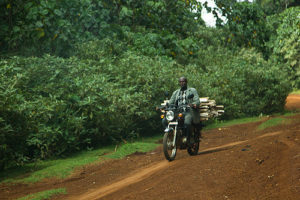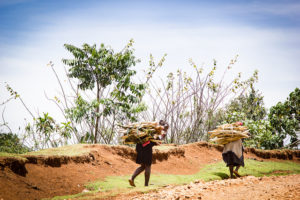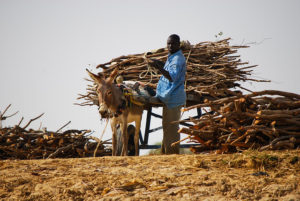
Nearly every rural family in the 49 countries of sub-Saharan Africa relies on wood to cook, boil water, provide heat and often to build their homes. Even in many urban areas, wood is the only affordable energy source.
Since wood fuel is here to stay, at least for now, scientists from the Center of International Forestry Research (CIFOR) wanted to find out how countries in the region prioritized this energy source as part of the climate actions they intend to take under the Paris Agreement.
Known as Intended Nationally Determined Contributions (INDCs), these proposed action plans were drawn up before the accord was signed in 2015 and will help determine if the world can achieve the Paris goals. Since Paris, the ‘intended’ has been dropped and countries have submitted their final plans, or Nationally Determined Contributions (NDCs).
The CIFOR team, including scientists part of the CGIAR Research Program on Forests, Trees and Agroforestry (FTA), examined how wood fuel was introduced, listed or framed in the NDCs; the existence or listing of renewable energy and energy efficiency plans; and the existence of supporting national policies and strategic documents.
“We looked at 22 randomly selected countries and their planned climate actions. Although wood fuel is mentioned in most plans, they don’t say how they intend to reach their targets or what the roadmaps, timelines and legal issues are,” says Christopher Martius, CIFOR scientist and team leader. “These plans are ambitious but they are mainly a declaration of intentions.”
The researchers found that even when plans were converted from INDCs to NDCs, just over half of the countries left out a budget or had any specific energy policies in their national planning strategies.
“It appears a lot of these countries rushed to get their [INDC] plans in place and they didn’t take the opportunity to revise them before they were automatically converted to NDCs. So they were basically a copy and paste exercise,” says Ivy Amugune, CIFOR research assistant.
One exception is Somalia, which revised and resubmitted its plan. It was also the only country to provide a detailed section on the environmental impact of charcoal. Somalia’s NDCs list renewable energy as one possible solution, but funding remains an issue.
Read more: Measuring the effectiveness of subnational REDD+ initiatives

THE COST OF GOING GREEN
Renewable energy sources — mainly wind, solar and hydropower — were mentioned as alternatives by 17 countries in their action plans but implementing this strategy may not be so easy.
“Biofuels and solar energy projects have been introduced in some rural areas, but they come with a price, especially in remote areas,” says Amugune. “The problem is that setting up these systems and maintaining them costs money. Wood fuel is cheap — in fact, for most people, it is actually free.”
But rapid deforestation in many countries is making it more and more difficult for communities to harvest wood fuel.
“In Kenya, for example, you find people in rural areas have to walk for miles now to get wood and water. Changes in rainfall are occurring due to climate change. The land dries out and then suddenly there is flooding. It destroys everything and people have to start again from zero,” says Amugune.
So how can communities continue to access wood fuel without harming the environment and contributing to climate change?
The researchers looked into the question but found that few countries have evaluated this aspect, even though wood fuel has the potential to be a clean and sustainable resource. Martius says the key is good forest management.
“If you have a rotation-based strategy with communities reforesting areas and then harvesting specific areas at alternate times wood fuel can be sustainable,” he says.
This rotation system can help restore the rapidly disappearing landscapes, researchers say. “But we need more research into tree species as well as a lot of planning and control to make that happen,” says Martius.
Read more: An introduction to CIFOR’s global comparative study on REDD+ (GCS-REDD+)
PROTECT AND RESTORE
Reforestation and the restoration of ecosystems are key elements to meeting the Paris goals. Forests that are legally protected can provide a positive “carbon sink,” which absorbs more carbon than it emits into the atmosphere.
Scientists say these areas need to be protected from firewood extraction and illegal logging. But only five of the countries examined seemed to recognize the importance of this in their NDCs.
Amugune says communities need to have a good reason to restore degraded landscapes. She points to Uganda where rural communities tend to plant fast-growing species like cyprus and eucalyptus, which can be harvested and sold in a few years.
“These communities need concrete incentives to grow indigenous trees to help restore degraded ecosystems and that requires government policies and good reforestation programs,” she says.

BOTTOM UP, TOP DOWN
Amugune says a real solution involves empowering communities. If they are given the responsibility for their own future then there is a real chance to achieve sustainability.
“I’ve seen NGOs or governments come with a great offer for a community and it’s a good project, but once it ends, the work on the ground dies. We have to find ways that these projects can have a life of their own even after a project ends. That’s the only way they can transform,” she says.
She adds that the research points to more regional cooperation, as many of the countries have the same problem and together they can find joint solutions.
Martius notes that the Paris accord has brought people together from developing and developed countries and from diverse backgrounds, and that means a real debate over solutions to climate change has begun.
“But we need to continue to engage with people, not just hand over reports or studies,” he says. “Above all, we need the right policies and enforcement of those policies. It’s not easy, but if you take a few years to develop and implement the right policy, then you don’t need to worry about the next 100 years.”
By Suzanna Dayne, originally published at CIFOR’s Forests News.
This research is part of CIFOR’s Global Comparative Study on REDD+.
This research forms part of the CGIAR Research Program on Forests, Trees and Agroforestry, which is supported by CGIAR Fund Donors.











